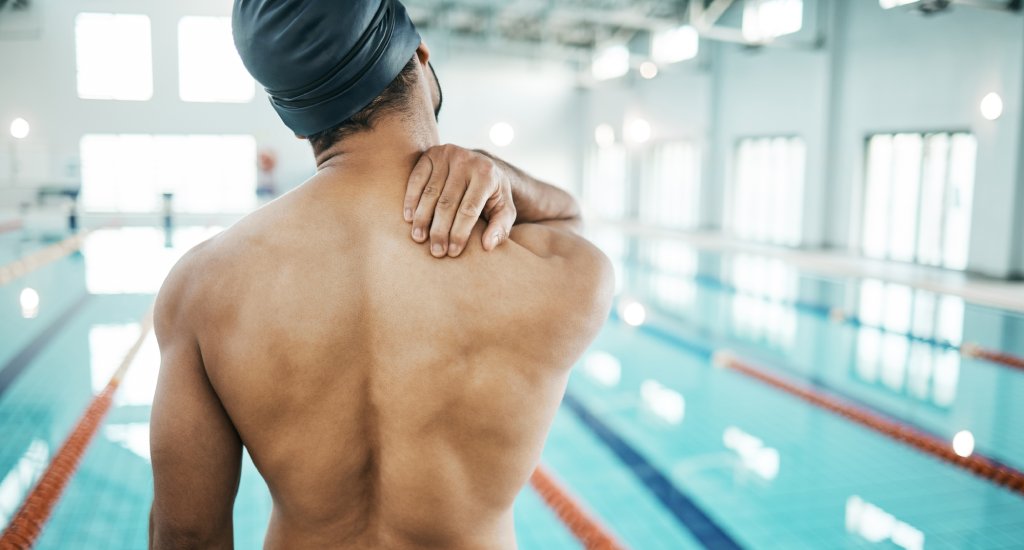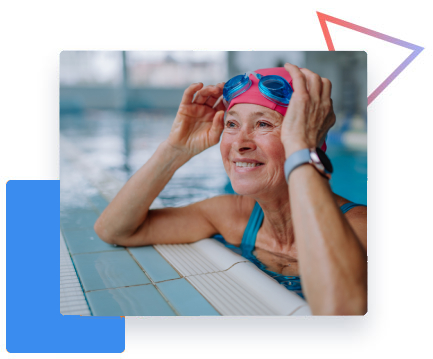Swimming
Common Swimming injuries and how to solve them

Swimming And Sports Injuries
Swimming is a physically demanding sport and offers a comprehensive full-body workout. As a low-impact exercise, swimming is gentle on the joints while effectively engaging major muscle groups.
The continuous resistance of the water challenges the body's strength and endurance, particularly in the arms, shoulders, and core. The repetitive kicking motions involved in various strokes target the legs, enhancing lower body strength and flexibility. Additionally, swimming demands cardiovascular fitness, as sustained swimming improves lung capacity and overall respiratory health.
The constant movement in the water requires coordination, balance, and agility, fostering better motor skills. Overall, swimming is an excellent way to maintain physical health, build muscular strength, and enhance cardiovascular endurance while minimising the risk of injury associated with higher-impact activities.

Solve Your Swimming Injury Today
Book now with one of our qualified therapists who are ready and waiting to help solve your swimming injury.
Book AppointmentCommon Swimming Injuries
Here are some of the most common swimming injuries we see at the Horsham Sports Injury Clinic
Swimmer's Shoulder
Swimmer's shoulder is a common injury caused by overuse of the shoulder joint. The repetitive arm movements involved in swimming, especially in front crawl and butterfly strokes, can lead to inflammation and pain in the rotator cuff tendons and shoulder joint.
Rotator Cuff Tears
Similarly, the repetitive overhead motions in swimming can put stress on the rotator cuff muscles, leading to tears or strains. This injury is more common in competitive swimmers or those who swim with improper technique.
Lower Back Pain
Improper body position during swimming, such as arching the back excessively or using an incorrect kicking technique, can strain the lower back muscles, leading to pain and discomfort.
Neck Strain
Freestyle and butterfly strokes require a lot of head movement, which can strain the neck muscles, especially if swimmers do not maintain proper alignment or turn their heads too far during breathing.
Knee Injuries
Breaststroke and butterfly kicks can put a lot of stress on the knees. Kicking excessively or with improper form can lead to knee pain and potential injuries like patellofemoral pain syndrome or swimmer's knee.
Calf Cramps
Dehydration, electrolyte imbalances, and improper kicking technique can cause painful calf cramps during or after swimming.
Achilles Tendinitis
Overuse of the ankle joint during swimming, particularly in backstroke and freestyle kicks, can lead to inflammation and pain in the Achilles tendon.
Shin Splints
Frequent and intense pushing off the pool wall can cause shin splints, leading to pain and inflammation along the front of the lower leg.
Plantar Fasciitis
The repetitive motion of the feet during swimming can lead to inflammation of the plantar fascia, resulting in heel pain and discomfort.
At Home Treatment Options
Here are some at-home exercises that can help prevent swimming injuries by strengthening key muscle groups and improving flexibility
Shoulder Blade Squeezes
- Sit or stand with good posture and gently squeeze your shoulder blades together, holding for a few seconds
- This exercise helps strengthen the muscles that support the shoulders and can prevent swimmer's shoulder
Rotator Cuff Exercises
- Perform exercises like external rotations using resistance bands or light dumbbells to strengthen the rotator cuff muscles
- This can help prevent rotator cuff tears and strains
Core Strengthening
- Engage your core with exercises like plank variations, bicycle crunches, or leg raises
- A strong core helps stabilise the spine during swimming and reduces the risk of lower back pain
Neck Stretches
- Gently stretch your neck muscles by tilting your head from side to side and forward and backward
- These stretches can help prevent neck strain during swimming
Knee Strengthening
- Perform exercises like squats, lunges, and step-ups to strengthen the muscles around the knees and improve stability during swimming
Ankle Mobility Exercises
- Rotate your ankles clockwise and counterclockwise to improve ankle flexibility and prevent issues like Achilles tendinitis
Calf Stretches
- Stretch your calf muscles by leaning against a wall with one foot forward and the other backward, keeping both heels flat on the ground
- This can help prevent calf cramps during swimming
Shin Strengthening
- Use resistance bands to perform dorsiflexion exercises, pulling your toes toward you against the band's resistance
- This can help prevent shin splints
Plantar Fascia Stretches
- Stretch the bottom of your feet by rolling a tennis ball or a frozen water bottle under your foot
- This can help prevent plantar fasciitis
Cardiovascular Conditioning
- Engage in regular cardiovascular exercises like walking, jogging, or cycling to maintain overall fitness and cardiovascular endurance
- This can benefit your swimming performance and reduce the risk of injuries
Testimonials
Hear What Our Patients Say



